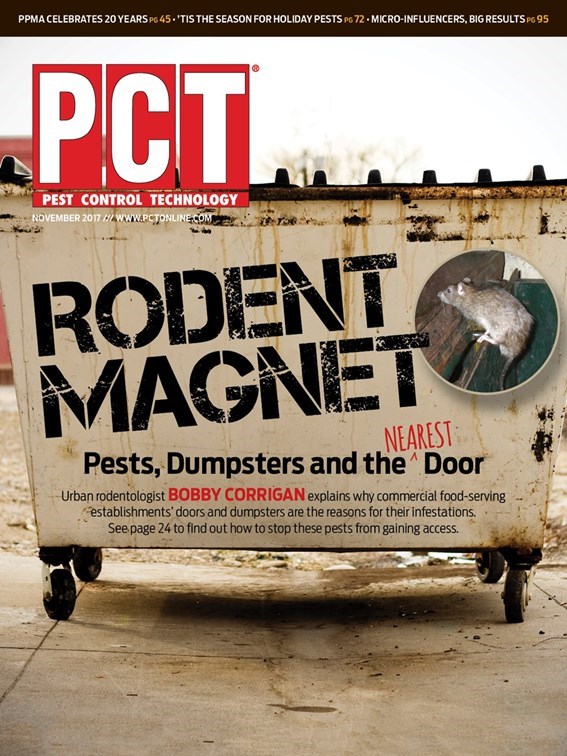
Editor’s Note: This article was reprinted with permission from Techletter, a biweekly training letter for professional pest control technicians from Pinto & Associates. To subscribe, visit www.techletter.com.
The effectiveness of “pest-proofing,” or eliminating openings, for insects is often debated. But pest-proofing for larger animals such as rats has been shown to be an effective technique, especially as part of an integrated program involving other control measures.
“Rat-proofing” is a specialized version of pest-proofing. The primary purpose of rat-proofing is to keep rats out of the building (exclusion). When you have an ongoing problem with rats in an account, baiting and trapping alone may not do the job. You may find yourself simply harvesting rats that are quickly replaced by new rats moving in.
Indoor rat-proofing also can be used to control the movements of rats within a building (isolation). Sealing openings and blocking travel routes can confine rats to a certain section of a building, making them easier to control. High-risk areas, such as the loading dock, receiving or compactor room, can be physically isolated from the rest of the building.
Structural rat-proofing can be very labor intensive, depending on the size, age and condition of the building. Rat-proofing can involve everything from caulking cracks, screening vents and eaves, and sealing openings where pipes and utility lines enter, to reinforcing places where rats have gnawed, installing sweeps and metal kick plates on doors, and placing metal rodent guards on overhead pipes in commercial buildings. The work may be done by your company or by the client or by the client’s contractor. As the rodent expert, you can identify and document problem areas to be sealed and make sure that susceptible sites are protected from rat gnawing.
SEAL CRACKS OR GAPS. You’ve heard it said that if a rat can get his head through an opening, he can get the rest of his body through, too. To truly rat-proof a building, you need to eliminate every critical opening that is larger than ¼ inch. Caulk openings beneath sinks, stoves and dishwashers. Use concrete or masonry grout to fix cracks in foundations and floors. Check roof joints and the areas where chimneys and fireplaces come through the floor from the cellar or crawlspace. Look for gaps around ground floor or below-grade windows and window wells.
REPAIR HOLES. Use strong materials such as ½-inch hardware cloth, welded wire mesh, sheet metal plates, concrete mortar, copper gauze or steel wool with expanding foam sprayed over it. It’s important to use the right materials for rat-proofing since rats can chew through wood, soft materials, plasterboard, plastic and many other materials.
SEAL OPENINGS AROUND PIPES. Plug gaps around water, gas or heat pipes. For large holes around pipes, use galvanized metal pipe chase covers, sheet metal plates, mortar, plaster of Paris or cement. Wrap pipes that run along walls with sheet metal guards that fit closely to the wall and keep rats from climbing the pipe or cable.
PAY SPECIAL ATTENTION TO DOORS. In commercial accounts, add metal kickplates to the outside bottoms of doors, especially those leading to warehouses or food storage areas. Use 26-gauge sheet metal mounted no more than ¼ inch from the bottom of the door. Large commercial doors should close flush to the ground. In warehouses and other areas where people forget to close doors, install automatic door-closers or alarms. Exterior doors should have thresholds with weather stripping, sweeps or strip seals at the base. Garage doors and bay or delivery doors usually need new rubber gaskets at the bottom and sides. Trash chutes, laundry chutes and elevator shafts should be checked for rat access points.
CHECK VARIOUS VENT OPENINGS. Replace or rescreen stove exhaust, clothes dryer, roof, ridge-line or soffit vents. Screen vents with ½-inch woven or welded hardware cloth or special vent covers; use metal louvers on soffits. Seal space around heat registers, furnace and air conditioning ducts and attic fan openings.
CHECK FOR SEWER ENTRY POINTS. Check sewer outlets, repair broken sewer pipes, screen drains in basements and shower rooms with ½-inch woven or welded hardware cloth. Commercial floor drains should have a perforated metal drain cover that may need to be screwed down if rats can move it.
PAY ATTENTION TO ROOFS. Roof rats (and sometimes Norways) enter mostly near the roof line. Check attic or gable vents, utility line openings, other openings near the roof line and branches touching the roof. On flat commercial rooftops, look for gaps around headhouses, elevator shafts, pipes and utilities, air conditioning units and other roof structures. Screen rooftop ventilator openings, being careful to not restrict airflow.
The authors are well-known industry consultants and co-owners of Pinto & Associates.

Explore the November 2017 Issue
Check out more from this issue and find you next story to read.
Latest from Pest Control Technology
- Orkin Helps Local Youth Sports Program Design a ‘Killah’ New Logo
- ABC Home & Commercial Services Celebrates 75 Years in Business
- NPMA Academy Announces Full Schedule
- Truly Nolen Promotes Marchello, Christopherson and Bolton to Managerial Positions
- TruGreen Announces 2024 List of Top 20 U.S. Buggiest Cities
- Why PMPs Use Rodent Bait Stations
- NPMA’s Women’s Forum Encouraged Female Leadership, Growth Opportunities in Pest Control
- GoPest Expands to Birmingham and Huntsville (Ala.)





